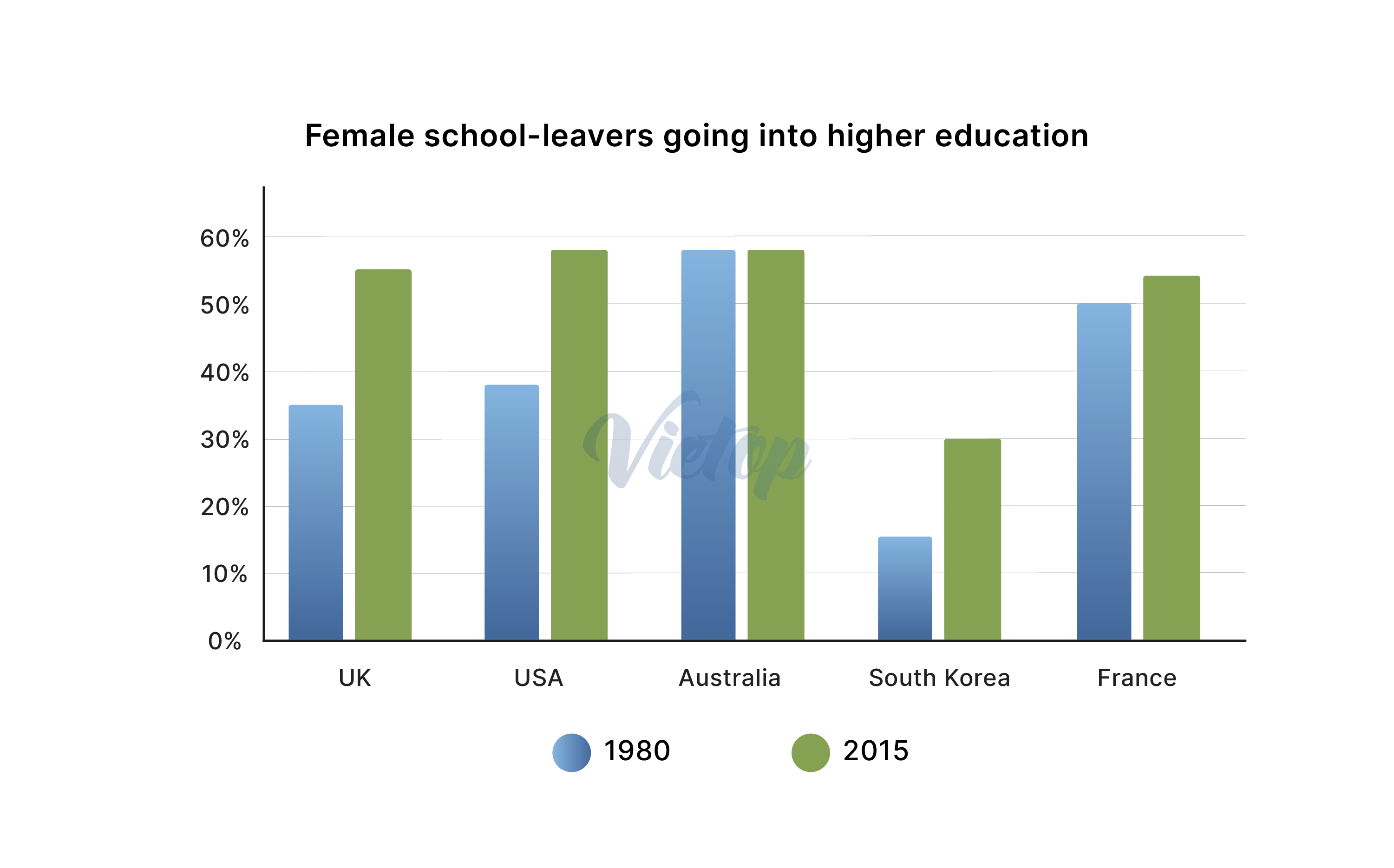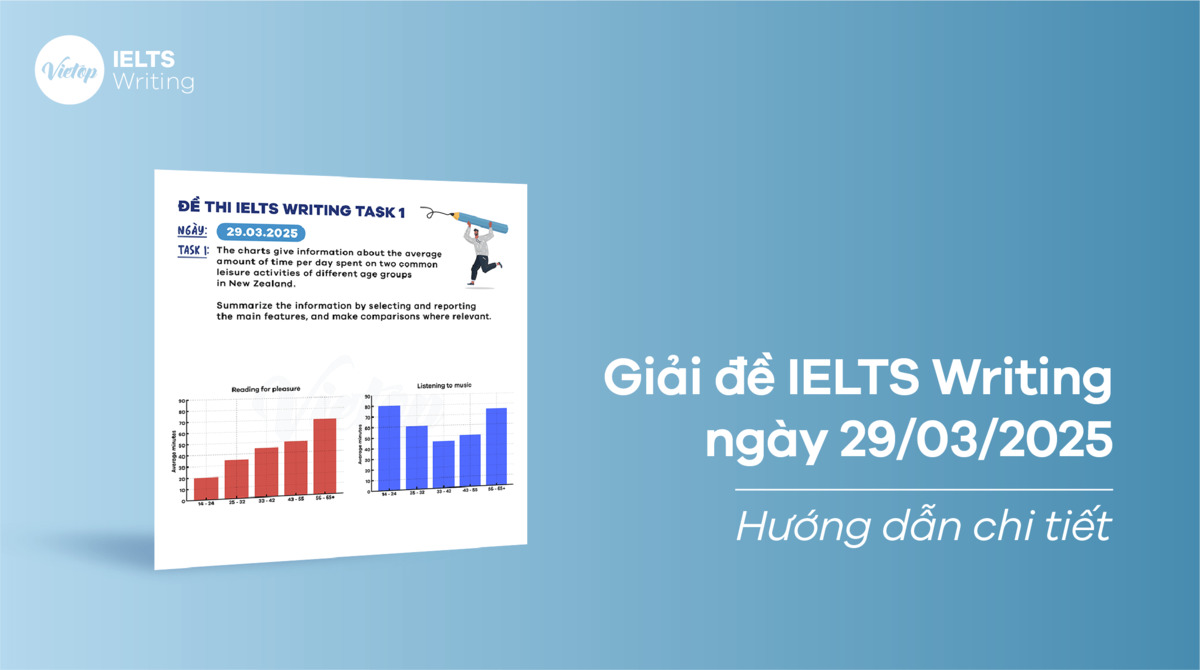Topic Women – IELTS Writing samples có thể được xem là tương đối khó nhằn đối với phần lớn học viên do chúng ta thật sự không có quá nhiều kiến thức cũng như lượng từ vựng tương thích với chủ đề này. Nội dung bài viết này, Vietop English sẽ giới thiệu một số từ vựng liên quan và bài viết mẫu để tham khảo về topic Women – IELTS Writing samples này nhé.
IELTS Writing task 1
TASK 1: The chart gives information on the percentage of women going into higher education in five countries for the years 1980 and 2015.

Sample
The given bar chart delineates a comparison of the proportion of female school-leavers participating in higher education in five developed countries between 1980 and 2015.
Overall, the percentage of women pursuing advanced studies showed an upward trend, except for in Australia where the trend was fairly stable from 1980 to 2015. Also, Australian women consistently had the highest participation rate in higher education, while South Korea recorded the lowest figure over the same time frame.
In 1980, females going into higher education in Australia accounted for approximately 60%, ranking first among the given countries. France followed closely behind at 50%, while the USA and the UK made up about 38% and 35%, respectively. With only around 15% of women joining higher education, South Korea had the lowest rate, significantly lagging behind other countries this year.
Turning to 2015, the most notable changes were the increases in female school-leavers enrolling in higher education in the USA and the UK, with the former jumping to almost 60% – a similar percentage as in Australia, and the latter rising to 55% – as the case in France. South Korea, despite a two-fold growth rate of 15%, was again the country with the lowest proportion.
Vocabulary
- lagging behind (verb phrase): tụt lại phía sau
- two-fold growth rate (noun phrase)): tỉ lệ tăng gấp đôi
Khóa luyện IELTS Cấp tốc tại Vietop cung cấp một lộ trình học tập hiệu quả, giúp bạn làm chủ kỹ năng phân tích và trình bày thông tin trong dạng bar chart và các dạng bài Writing khác. Với đội ngũ giáo viên giàu kinh nghiệm, Vietop English cam kết sẽ giúp bạn đạt được kết quả tốt nhất trong kỳ thi IELTS với điểm số mục tiêu.
Phân tích
Nhìn chung, tỉ lệ phụ nữ tham gia học cao ở các quốc gia có xu hướng tăng, ngoại trừ nước Úc nơi có xu hướng khá ổn định. Thêm vào đó, nước Úc cũng là quốc gia có tỉ lệ phụ nữ học cao học nhìn chung là cao nhất so với tất cả các nước còn lại, trong khi đó nước Bắc Triều Tiên có tỉ lệ thấp nhất trong khung thời gian được đề cập.
Lưu ý: Với bài có hai mốc thời gian, hướng đi hợp lý là tìm kiếm sự tăng, giảm, hay không đổi của các đối tượng để nêu bật trong phần tổng quan, đồng thời so sánh chung để chỉ ra đối tượng có số liệu cao – lớn nhất và ngược lại. Phần thân bài nên chia thành từng mốc thời gian để viết; sắp xếp thứ tự từ lớn xuống bé của các đối tượng để làm rõ sự so sánh.
Qua khung thời gian thứ hai, sẽ viết về xu hướng tăng giảm kết hợp chung sự so sánh giữa các đối tượng đáng chú để để làm nổi bật số liệu… Một số cụm, cấu trúc và ngữ pháp nhằm tạo sự đa dạng: “showed an upward trend”; “the trend was fairly stable”; “followed closely behind”; “significantly lagging behind other”; “the former jumping to”; “the latter rising to”; “despite a two-fold growth rate”.
Xem thêm:
Chủ đề Gender Equality – IELTS Writing Task 2
IELTS Writing task 2
TASK 2: Some people believe that women should play an equal role as men in a country’s police force or military force, while others think women are not suitable for these kinds of jobs. Discuss both views and give your opinion.
Sample
The position of women in the armed forces offers a striking and illustrative case for the changing role of women in occupations and bureaucratic structures. In my opinion, though women are not typically considered suited for such roles, there should be gender equality in these fields.
Proponents of women’s exclusion from the police or military forces often contend that these positions can have a number of disadvantages. They assert that women may lack physical strength and combat skills as compared to men. The demanding nature of these occupations includes combat situations and physical confrontations, which often put women at a disadvantage.
This is demonstrated clearly when a policewoman confronts an armed criminal in a store as she may face challenges in successfully subduing the criminal and ensuring the safety of everyone involved. This is due to the criminal’s physical advantage, their aggressive intent, and the need for swift action. Another risk for women in the police or military forces is dealing with an increased risk of abuse. Sometimes, this is both by members of their own unit or by potential enemy combatants if they are captured.
Nevertheless, the incorporation of women in direct combat roles and in administrative positions can be beneficial. One significant advantage is gender equality. The role of women in society was historically restricted to bearing kids and managing household affairs. Women should now take on responsibilities and adopt an active role in fields that were once considered the traditional domain of men, as it is now generally acknowledged that all humans are equal. Another advantage is that a female figure serving in the armed forces can serve as a positive role model for women in general. They can be an excellent example for those who wish to follow in their footsteps and demonstrate that they are capable of performing any task.
In conclusion, regardless of physical and potential skills differences, the benefits in terms of gender equality and providing a positive role model make the incorporation of women in the police or military forces overall positive. It is the responsibility of both the government and society at large to acknowledge the role of women and develop a plan for the approval and inclusion of women in all spheres of life.
Vocabulary
- Combat skills (noun phrase): kỹ năng chiến đấu
- Confrontations (noun): những cuộc đối đầu
- Risk of abuse (noun phrase): nguy cơ bị lạm dụng
- Enemy combatants (noun phrase): những kẻ địch trong chiến đấu
- Adopt (verb): đảm nhận
- Traditional domain (noun phrase): lĩnh vực truyền thống
- At large (adv): as a whole, tổng thể, nhìn chung
- Spheres of life (noun phrase): các lĩnh vực của cuộc sống
Phân tích
Quan điểm: Mặc dù phụ nữ không được xem là phù hợp với việc làm cảnh sát hay quân nhân, theo ý kiến cá nhân thì sự bình đẳng giới vẫn nên được thực thi trong các lĩnh vực này.
Ủng hộ việc không cho phụ nữ tham gia lực lượng cảnh sát hoặc quân đội:
- Có thể thiếu sức mạnh về thể chất và kỹ năng chiến đấu so với nam giới, do đặc thù của ngành đòi hỏi cao về các tình huống chiến đấu và đối đầu vật lý, thường khiến phụ nữ có thể bị tổn thương hơn.
- Đối mặt với nguy cơ bị lạm dụng gia tăng; đôi khi là từ chính đồng nghiệp trong ngành hoặc từ những kẻ mà họ bắt giữ
Tuy nhiên, việc đưa phụ nữ vào các vai trò trong ngành cảnh sát và quân đội có thể mang lại lợi ích:
- Thể hiện sự bình đẳng giới tính: đã không còn thời mà phụ nữ bị mặc định cho việc sinh con và chăm sóc việc nhà
- Những người phụ nữ này có thể là một tấm gương tích cực cho phụ nữ nói chung.
Xem ngay: Tổng hợp đề thi IELTS Writing 2023 kèm bài mẫu chi tiết
Thông qua bài viết chắc hẳn các bạn đã có cho mình thêm những kinh nghiệm và cách hoàn thiện Topic Women – IELTS Writing samples. Nếu các bạn có thắc mắc hoặc có những đề tài thú vị khác thì có liên hệ với Vietop nhé, Vietop English sẽ luôn cố gắng dễ hỗ trợ bạn tốt nhất.
Xem ngay: Khóa học IELTS Cấp Tốc – Cam kết tăng ít nhất 0.5 – 1.0 band score SAU 1 THÁNG HỌC


![[ACE THE TEST] Giải đề IELTS Writing ngày 07/04/2025](https://vietop.edu.vn/wp-content/uploads/2025/04/giai-de-ielts-writing-ngay-07-04-2025.png)

![[ACE THE TEST] Giải đề IELTS Writing ngày 15/03/2025](https://vietop.edu.vn/wp-content/uploads/2025/03/giai-de-ielts-writing-ngay-15-03-2025.jpg)
![[ACE THE TEST] Giải đề IELTS Writing ngày 22/03/2025](https://vietop.edu.vn/wp-content/uploads/2025/03/giai-de-ielts-writing-ngay-22-03-2025.jpg)
![[ACE THE TEST] Giải đề IELTS Writing ngày 08/03/2025](https://vietop.edu.vn/wp-content/uploads/2025/03/giai-de-ielts-writing-ngay-08-03-2025.jpg)
![[ACE THE TEST] Giải đề IELTS Writing ngày 06/03/2025](https://vietop.edu.vn/wp-content/uploads/2025/03/giai-de-ielts-writing-ngay-06-03-2025.jpg)
![[ACE THE TEST] Giải đề IELTS Writing ngày 22/02/2025](https://vietop.edu.vn/wp-content/uploads/2025/02/giai-de-ielts-writing-ngay-22-02-2025.jpg)
